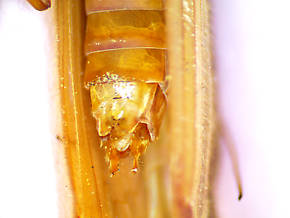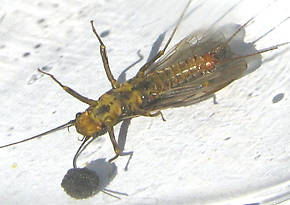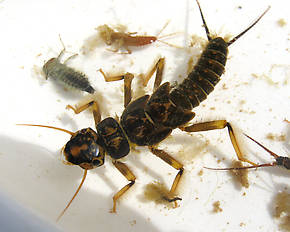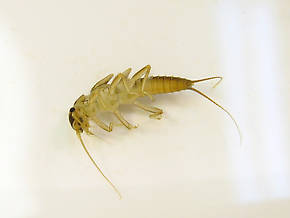Blog & Latest Updates
Fly Fishing Articles
Insects by Common Name


Latest updates, page 41
Updates from April 19, 2013
Updates from April 9, 2013
Closeup insects by Taxon from Spring Brook in WA
Male Psychoglypha (Snow Sedges) Caddisfly Adult View 2 PicturesThis Psychoglypha adult was found clinging to my garage door in the evening on April 9, 2013. It measures 21 mm in length, from the front of head to the end of wings. It is my hope that Creno will be able to identify it to species based on the image of its genitalia. However, if other images are required for a species ID, the specimen is available, so they can be easily taken. Thanks, Roger Rohrbeck, Mercer Island, WA.
View 2 PicturesThis Psychoglypha adult was found clinging to my garage door in the evening on April 9, 2013. It measures 21 mm in length, from the front of head to the end of wings. It is my hope that Creno will be able to identify it to species based on the image of its genitalia. However, if other images are required for a species ID, the specimen is available, so they can be easily taken. Thanks, Roger Rohrbeck, Mercer Island, WA.
 View 2 PicturesThis Psychoglypha adult was found clinging to my garage door in the evening on April 9, 2013. It measures 21 mm in length, from the front of head to the end of wings. It is my hope that Creno will be able to identify it to species based on the image of its genitalia. However, if other images are required for a species ID, the specimen is available, so they can be easily taken. Thanks, Roger Rohrbeck, Mercer Island, WA.
View 2 PicturesThis Psychoglypha adult was found clinging to my garage door in the evening on April 9, 2013. It measures 21 mm in length, from the front of head to the end of wings. It is my hope that Creno will be able to identify it to species based on the image of its genitalia. However, if other images are required for a species ID, the specimen is available, so they can be easily taken. Thanks, Roger Rohrbeck, Mercer Island, WA.Updates from March 22, 2013
Closeup insects by Entoman from the Lower Yuba River in CA
Female Skwala curvata (Large Springfly) Stonefly Adult View 2 PicturesThis female dropped her eggs just before this photo was snapped. The distinctive notch in the subgenital plate identifies the species. An interesting observation is how active they get when exposed to direct sunlight. Trying to stage this specimen was most difficult. In the shade it would calm right down, but when exposed to direct sun it would immediately go nuts, scampering all over quickly without pause. Perhaps this explains why they don't seem to be found out and about on overcast days, but if the sun peeks out... She was 24 mm long, head to wingtip.
View 2 PicturesThis female dropped her eggs just before this photo was snapped. The distinctive notch in the subgenital plate identifies the species. An interesting observation is how active they get when exposed to direct sunlight. Trying to stage this specimen was most difficult. In the shade it would calm right down, but when exposed to direct sun it would immediately go nuts, scampering all over quickly without pause. Perhaps this explains why they don't seem to be found out and about on overcast days, but if the sun peeks out... She was 24 mm long, head to wingtip.
 View 2 PicturesThis female dropped her eggs just before this photo was snapped. The distinctive notch in the subgenital plate identifies the species. An interesting observation is how active they get when exposed to direct sunlight. Trying to stage this specimen was most difficult. In the shade it would calm right down, but when exposed to direct sun it would immediately go nuts, scampering all over quickly without pause. Perhaps this explains why they don't seem to be found out and about on overcast days, but if the sun peeks out... She was 24 mm long, head to wingtip.
View 2 PicturesThis female dropped her eggs just before this photo was snapped. The distinctive notch in the subgenital plate identifies the species. An interesting observation is how active they get when exposed to direct sunlight. Trying to stage this specimen was most difficult. In the shade it would calm right down, but when exposed to direct sun it would immediately go nuts, scampering all over quickly without pause. Perhaps this explains why they don't seem to be found out and about on overcast days, but if the sun peeks out... She was 24 mm long, head to wingtip.Collected March 22, 2013 from the Lower Yuba River in CA
Added to Troutnut.com by Entoman on March 27, 2013
Added to Troutnut.com by Entoman on March 27, 2013
Hesperoperla pacifica (Golden Stone) Stonefly Nymph View 1 PicturesThis monster started to feed within a few minutes of sharing the inspection tray with its victims. This nymph is a voracious predator of small invertebrates and has even been noted for feeding on small fish and salmonid alevins. The niche it fills in fast water is equivalent to the Dragonfly nymphs that inhabit slower water.
View 1 PicturesThis monster started to feed within a few minutes of sharing the inspection tray with its victims. This nymph is a voracious predator of small invertebrates and has even been noted for feeding on small fish and salmonid alevins. The niche it fills in fast water is equivalent to the Dragonfly nymphs that inhabit slower water.
Hesperoperla pacifica nymphs are easily distinguished from other western perlids by the presence of anal gills (obfuscated by algae in the tray) in combination with an hour glass shaped pale mark on the front of their heads.
 View 1 PicturesThis monster started to feed within a few minutes of sharing the inspection tray with its victims. This nymph is a voracious predator of small invertebrates and has even been noted for feeding on small fish and salmonid alevins. The niche it fills in fast water is equivalent to the Dragonfly nymphs that inhabit slower water.
View 1 PicturesThis monster started to feed within a few minutes of sharing the inspection tray with its victims. This nymph is a voracious predator of small invertebrates and has even been noted for feeding on small fish and salmonid alevins. The niche it fills in fast water is equivalent to the Dragonfly nymphs that inhabit slower water.Hesperoperla pacifica nymphs are easily distinguished from other western perlids by the presence of anal gills (obfuscated by algae in the tray) in combination with an hour glass shaped pale mark on the front of their heads.
Collected March 22, 2013 from the Lower Yuba River in CA
Added to Troutnut.com by Entoman on April 4, 2013
Added to Troutnut.com by Entoman on April 4, 2013
Updates from March 15, 2013
Closeup insects by Entoman from the Lower Yuba River in California
Isoperla quinquepunctata (Little Yellow Stonefly) Little Yellow Stonefly Nymph View 3 PicturesThe dorsal (Dorsal: Top.) patterning is quite unique.
View 3 PicturesThe dorsal (Dorsal: Top.) patterning is quite unique.
Entoman
 View 3 PicturesThe dorsal (Dorsal: Top.) patterning is quite unique.
View 3 PicturesThe dorsal (Dorsal: Top.) patterning is quite unique.Entoman
Collected March 15, 2013 from the Yuba River in California
Added to Troutnut.com by Entoman on April 20, 2013
Added to Troutnut.com by Entoman on April 20, 2013
The Mind of the Trout -- my review of a really interesting book
I took advantage of a long flight back to Alaska yesterday to finish reading Thomas Grubb's 2003 book, The Mind of the Trout. It's very good. I'm surprised to see it hasn't come up in discussions here yet, because this site caters directly to the book's target audience of scientifically curious fly anglers.

Most scientifically oriented fly fishing books focus on the insects trout eat, just like the aquatic insect encyclopedia on this site. We devote hours upon hours to learning how to distinguish between nearly identical mayflies using microscopic features. While some entomology does help us catch more fish, we take it to levels that would be absurd if catching more fish were our only purpose. We really do these things because we enjoy every minute on the river more deeply when we better understand what's going on around us. The cycles of aquatic life are fascinating dramas, and dramas are more enjoyable when the characters are well developed. When we understand the life story of each insect we see, when we know the trials and tribulations of its life cycle, the whole experience is more profound. Entomology tells us about the characters in the stories we witness on the river.
It seems odd, then, that we largely overlook one character in our hunger for scientific detail: the trout. We have plenty of observations of trout behavior as it relates to catching them: where they like to feed, how to avoid scaring them, what time of day to pursue them, etc. That's good practical advice from angler to angler, and many of the best angling writers (like LaFontaine and Marinaro) were real scientific naturalists in all but formal title. But the scientific literature also holds some very interesting information about why trout do what they do, and angling writers have overlooked most of it.
The Mind of the Trout changes that. This book, written by a scientist with relevant expertise, very thoroughly summarizes the scientific literature on several subjects related to how trout live and, especially, how they think. It nicely ties in relevant science from other animals when an important question hasn't yet been studied in trout. The author adds excellent insights of his own to fill some of the gaps and tie scientific findings to angling. The book is written on a level for anglers who enjoy technical detail but are not steeped in the jargon of the field. However, I'm completing a Ph.D. on the behavioral ecology of salmonids, and I still learned a lot from this book. I can guarantee the same for anyone who reads it.
Whether or not this book is for you comes down to what you want to learn. Just like the technical books on fly fishing entomology, most of the book is superfluous to the task of catching trout. This is a book to help you appreciate the trout. It sometimes leaves us unsatisfied with how little is known about an interesting question, but that's not the book's fault -- it honestly summarizes the best science has to offer, but the scientific study of trout behavior and cognition is a young field that has barely scratched the surface of the difficult mysteries it's exploring.
I would not recommend this book to someone who picked up a fly rod for the first time last month. However, if you're the kind of angler who can name more than three stonefly mouth parts off the top of your head, but the term "optimal foraging theory" is unfamiliar and you can't fully describe the relationship between food, temperature, and trout growth, then I think you'll enjoy it as much as I did.

Most scientifically oriented fly fishing books focus on the insects trout eat, just like the aquatic insect encyclopedia on this site. We devote hours upon hours to learning how to distinguish between nearly identical mayflies using microscopic features. While some entomology does help us catch more fish, we take it to levels that would be absurd if catching more fish were our only purpose. We really do these things because we enjoy every minute on the river more deeply when we better understand what's going on around us. The cycles of aquatic life are fascinating dramas, and dramas are more enjoyable when the characters are well developed. When we understand the life story of each insect we see, when we know the trials and tribulations of its life cycle, the whole experience is more profound. Entomology tells us about the characters in the stories we witness on the river.
It seems odd, then, that we largely overlook one character in our hunger for scientific detail: the trout. We have plenty of observations of trout behavior as it relates to catching them: where they like to feed, how to avoid scaring them, what time of day to pursue them, etc. That's good practical advice from angler to angler, and many of the best angling writers (like LaFontaine and Marinaro) were real scientific naturalists in all but formal title. But the scientific literature also holds some very interesting information about why trout do what they do, and angling writers have overlooked most of it.
The Mind of the Trout changes that. This book, written by a scientist with relevant expertise, very thoroughly summarizes the scientific literature on several subjects related to how trout live and, especially, how they think. It nicely ties in relevant science from other animals when an important question hasn't yet been studied in trout. The author adds excellent insights of his own to fill some of the gaps and tie scientific findings to angling. The book is written on a level for anglers who enjoy technical detail but are not steeped in the jargon of the field. However, I'm completing a Ph.D. on the behavioral ecology of salmonids, and I still learned a lot from this book. I can guarantee the same for anyone who reads it.
Whether or not this book is for you comes down to what you want to learn. Just like the technical books on fly fishing entomology, most of the book is superfluous to the task of catching trout. This is a book to help you appreciate the trout. It sometimes leaves us unsatisfied with how little is known about an interesting question, but that's not the book's fault -- it honestly summarizes the best science has to offer, but the scientific study of trout behavior and cognition is a young field that has barely scratched the surface of the difficult mysteries it's exploring.
I would not recommend this book to someone who picked up a fly rod for the first time last month. However, if you're the kind of angler who can name more than three stonefly mouth parts off the top of your head, but the term "optimal foraging theory" is unfamiliar and you can't fully describe the relationship between food, temperature, and trout growth, then I think you'll enjoy it as much as I did.
Top 10 Fly Hatches
Top Gift Shop Designs
Eat mayflies.
Top Insect Specimens
Miscellaneous Sites
Troutnut.com is copyright © 2004-2024 Jason
Neuswanger (email Jason). See my FAQ for information about use of my images.
 privacy policy
privacy policy
